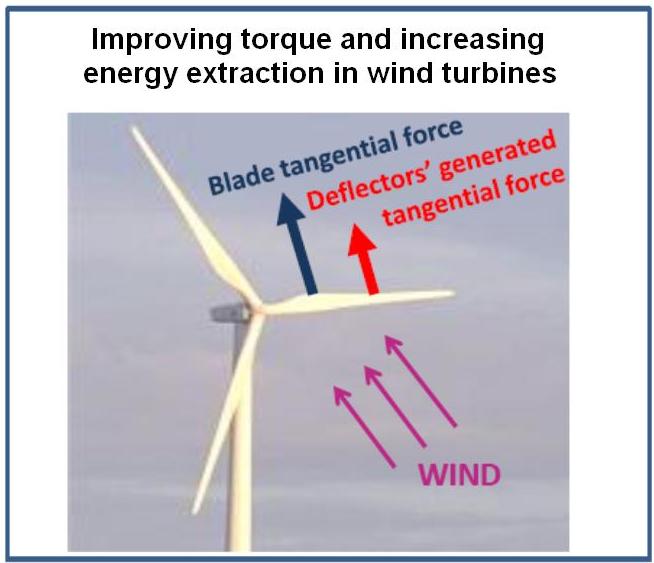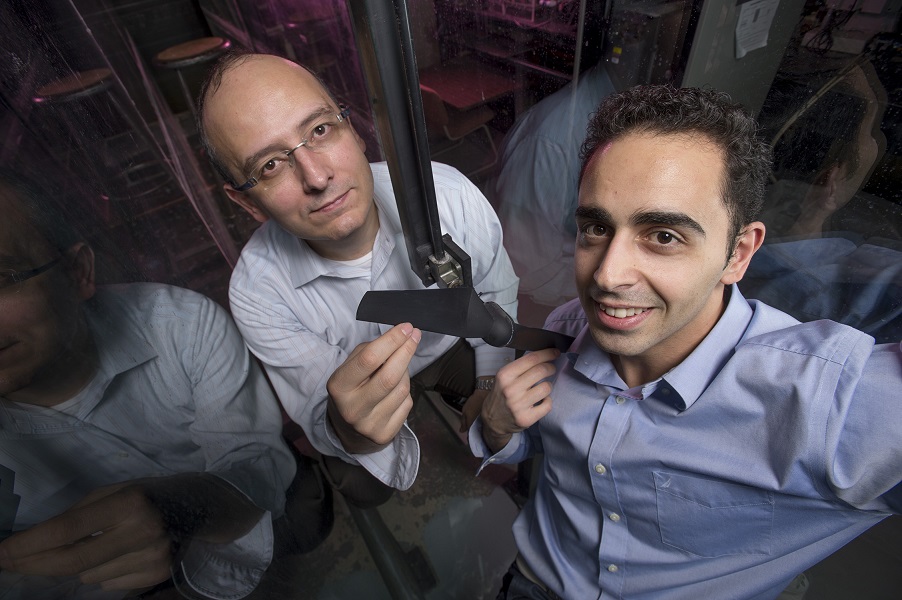Researchers at Rutgers University have invented and tested a patent-pending wind turbine blade deflector that creates a significant increase in torque. “The deflector, not a vortex generator, is based upon a powerful force that other airfoil designs don’t address,” says Corey Park, CEO of Dynamic Blade Technologies, a company formed to commercialize this technology and other turbine blade inventions. Mr. Park says that adding the deflector has the potential to boost turbine output in light to moderate winds by some 20%. For example, if a 3 MW turbine producing 1,000 kW in a particular wind were refitted with the deflectors, it would produce 1,200 kW. What’s more, a 5% power increase typically translates into a 20% increase in profit for turbine owners.
 Discoverer and developer Professor F. Javier Diez heads the Laboratory for Experimental Fluids and Thermal Engineering at Rutgers. Dr. Diez expects that the results could provide the same substantial increase and maybe more at higher wind speeds.
Discoverer and developer Professor F. Javier Diez heads the Laboratory for Experimental Fluids and Thermal Engineering at Rutgers. Dr. Diez expects that the results could provide the same substantial increase and maybe more at higher wind speeds.
Dr. Diez said “We are very excited about the data obtained from recent laboratory-scale tests and can’t wait to perform larger scale experiments to demonstrate the full potential of this technology.”
“Once the researchers were able to model the drag/lift phenomena, they reshaped the deflector in order to produce a higher torque,” says Park. He adds that Diez’s team completed 50 laboratory tests on a blade that confirms their initial projections. Because the university still owns the intellectual property for the deflector, Park was unable to provide an image of it. However, below is an image that shows how energy extraction improves with the deflector

Drs. Diez and Villegas, developers of the blade deflector, make adjustments to a model before a wind tunnel test.
Dynamic Blade Technologies is seeking investors as well as wind farm owners and operators interested in testing this new technology. Interested parties and investors can reach Corey Park at corey@windfarmtech.com.
This deflector technology was invented by Dr. F. Javier Diez and Mr. Arturo Villegas. Dr. Diez is an Associate Professor at the Department of Mechanical & Aerospace Engineering at Rutgers University. Dr. Diez is the head of the Laboratory for Experimental Fluids in the Department of Mechanical Engineering at Rutgers. He is an author of over 50 journal articles, conference papers, and technical publications, and has given over 15 invited lectures in the areas of thermal fluid sciences. His interests include wind turbines and other alternative energies, active flow control, turbulent flows, flow diagnostics, microfluidics, combustion and multiphase flows, all of which have important and diverse applications. His research has been funded by industry and government agencies such as NSF, ONR, NASA, FAA, DARPA, and AFOSR, among others.
Mr. Villegas is a PhD candidate at Rutgers in Mechanical and Aerospace Engineering and he led the wind turbine experiments. His experience and research in the fields of fluid mechanics, image velocimetry techniques and water-tunnel experiments contributed to development of the wind deflector.
The researchers add that the deflectors can be easily affixed to the blades of existing wind turbines. According to the Global Wind Energy Council, there are more than 225,000 large wind turbines around the globe. OEMs could also add the deflectors to new blades at their factories. What’s more, the deflectors could improve the performance of smaller turbines sold to individuals (Lowe’s currently sells a small residential wind turbine), hydroelectric plants, boat propellers, airplane wings, and helicopters.
Filed Under: Blades, News





bill, it is a 3 meg unit, 3000, so 1000 is a lower speed output, but wind tunnel testing is regarded as being only first step, how the wind around the actual turbine behaves is the critical factor
If they have a program to put one of these in my backyard I’m for it. Please contact me at my email address and we will talk about it.
There are problems with this write up. The article states this item improves output in low and moderate wind speeds, but the example given is calculated for maximum output , i.e., adding 20% to a 1000 unit to give 1200. Is there turbulent drag at super wind speeds? What do the researchers themselves estimate the overall integrated power output to be? The university owning the patent rights makes one question an important part of the discussion. In other words, how much do we get and what does it really cost?
Mr Hanners: You ask fair questions. I’ve been told the invention has been tested in a wind tunnel, which allowed providing the figures in the article, and that the developer is looking for a turbine on which to mount a prototype. Because of patent issues, the developer was hesitant to show an exact model of the device. I have been assured that more details will be forthcoming. –Paul Dvorak